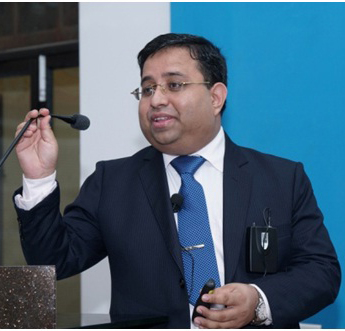Invited Speakers
Dr. Md. Mamun Habib,Professor
School of Business, Independent University, BangladeshVisiting Scientist, University of Texas - Arlington (UTA), USA
Speech Title: Big Data and Supply Chain Management: A Combination of Modern Management
Abstract: Advancement in information and communication technology (ICT) has given rise to explosion of data in every field of operations. Working with the enormous volume of data (or Big Data, as it is popularly known as) for extraction of useful information to support decision making is one of the sources of competitive advantage for organizations today. Supply Chain is a significant contributor to Big Data wherein the diversity of information is large. The data accumulated by Supply Chain contains information from the key entities such as manufacturing, logistics, and retail. The use of Big Data Analytics on a collection of such copious data sets can cultivate a proactive decision-making approach for predicting key opportunities and risks in Supply Chain. Big data used in supply chain management helps to create better customer demand planning strategies by collecting, documenting & analyzing data in a real situation. Big data combined a set of data usually referred as large and complex datasets; enables the company to review real-time data flows. Digitized supply chains have the potential to dramatically lower costs, reduce lead time and increase product availability. Digitization makes the supply chain more effective, agile and responsive by sharing knowledge and collaborating complex supplier networks. As a result, this research contributes the practitioners to identify the current situation of their business and it will help them to take timely, fast and better decision.
Keywords: Big Data, Supply Chain, Information Management
Dr. Jung Wan Lee, Professor
School of International Economics and Trade, Anhui University of Finance and Economics, ChinaSpeech Title: Big Data Strategies for Government, Society and Policy Making
Abstract: The paper aims to facilitate a discussion around how big data technologies and data from citizens can be used to help public administration, society, and policy making to improve community’s lives. This paper discusses opportunities and challenges of big data strategies for government, society, and policy making. This paper employs the presentation of numerous practical examples from different parts of the world, where public service delivery has seen transformation and where initiatives have been taken forward that have revolutionized the way governments at different levels engage with the citizens and how governments and civil society have adopted evidence driven policy making through innovative and efficient use of big data analytics. The examples include the governments of the United States, China, the United Kingdom, and India and different levels of government agencies in the public services of fraud detection, financial market analysis, healthcare and public health, government oversight, education, fighting crime, environmental protection, energy exploration, agriculture, weather forecasting, and ecosystem management. The examples also include smart cities in Korea, China, Japan, India, Canada, Singapore, the United Kingdom, and the European Union. This paper makes some recommendations how big data strategies transform the government and public services to become more citizen centric, responsive, accountable and transparent.
Keywords: Big Data, Big Data Strategy, Big Data Analytics, Public Goods, Public Services, Public Policy, Smart City
Dr. Omid M. Ardakani, Associate Professor
Parker College of Business, Georgia Southern University, USASpeech Title: Options Valuation in a High-frequency World
Abstract: An alternative approach to the Black-Scholes-Merton formulation of option valuation is the entropy pricing theory. Entropy pricing applies notions of information theory to derive the theoretical value of options. I elaborate further on the maximum entropy formulation of option pricing using a generalized set of moment constraints. Higher order moments contain more information about the price density and characterize the shape of the underlying distribution. In a Monte Carlo study, I present entropies of heavy-tailed distributions and show that entropic call densities vary with constraints and become closer to each other as the order of moments increases. In an empirical analysis using high-frequency S&P 500 index options, I examine the impact of moment constraints on the accuracy of theoretical values. Simulation and empirical evidence suggest that the entropic pricing framework provides more accurate results for heavy-tailed, high-frequency data when higher order moment constraints are imposed.
Dr. Lu Han, Associate Professor
Central University of Finance and Economics, ChinaSpeech Title: An Assertive Reasoning Method for Emergency Response Management Based on Knowledge Elements C4.5 Decision Tree
Abstract: The correct selection of knowledge elements is the key to emergency management. Using emergency knowledge elements, this study constructs an assertive reasoning selection methodology by improving acquisition on the balance coefficient in the C4.5 algorithm. Through hierarchical representation, a two level model selection method, based on a top model construction process as well as an underlying model selection process, is proposed. Specifically, the top model construction process is based on assertive reasoning and an underlying model selection process is based on the C4.5 decision tree. This method reduces the requirements for emergency domain knowledge, and improves the accuracy and timeliness. Lastly, the methodology is applied to the 2015 Tianjin explosions as a case study.
Dr. Francisco Daladier Marques Júnior, Professor
Computer Networks and Computer Networks Lab, IFPB, BrazilSpeech Title: How to optimize virtual networks over time: A fractal case of study by using multiplicative DEA models
Abstract: The fine-tuning from TCP/IP's transport layer is mandatory to reach out on how to implement the best way to deliver customer services on cloud computing or virtual network infrastructures. For this reason, this speech show as to evaluate the virtual networks using the fractal structure present on TCP protocol. The Internet Engineering Task Force (IETF) documents that are named by request of comments (RFCs) of numbers 2544 and 6815 were employed to mount the experiments using a great set of distinct virtual networks. So, the decision variables are the fractal dimension to show whether a service is delivered of a form smooth or jagged, as well as the TCP bandwidth and the fractal memory linked to Hurst's parameter. The main goal was to choose between diverse virtual network settings assessed by DEA models as decision-making units (DMUs) which is the best TCP's contract to carry the biggest amount of data in a stable manner over time. The classical static and dynamic DEA models were compared against the multiplicative DEA models, where the results show because we must use the multiplicative DEA models despite a set of other multi-criteria decision-making methods.
Keywords: Multiplicative Data Envelopment Analysis Models; Fractal Expert System; Virtual Networks; Network Optimization; Stepwise Performance Evaluation
Dr. Luis-Alberto Casado-Aranda, Assistant Professor
Department of Marketing and Market Research, University of Granada, SpainSpeech Title: The Strides of Consumer Neuroscience: Origin, Definition and Main Techniques
Abstract: Business and management research has traditionally turned to self-report methods, namely surveys, focus groups and interviews, to evaluate, understand and predict consumer behavior when exposed to advertising. These techniques capture conscious expressions, feelings and verbal-language-based on responses from consumers regarding advertising recall, brand awareness or purchase intentions. While they are commonly preferred by marketers because of their ease of use, accessibility and cost effectiveness, they are nonetheless subject to bias. They are in fact vulnerable to subjectivity and social desirability, may insert delicate questions (e.g. sexual or religion orientation), do not measure deeper emotions (e.g. ambiguity, risk), may not be able to apprehend cognitive and affective processes, and do not facilitate a moment-by-moment collection of data. Deficiencies in measuring consumer behavior in self-report tools have led to the search for more precise techniques coming from psychology and neuroscience to complement traditional market research methods. The combination of techniques from marketing, neuroscience and psychology has fostered the growth of a new field of marketing called consumer neuroscience, that overcomes most of the limitations of traditional tools. The current speech precisely outlines the origin and definition of this new branch of marketing, as well as its tools, journals and themes that are worth considering in future research. The current speech also facilitates an agenda for future research and therefore constitutes a starting point for business academics and professionals intending to resort to neuroimaging techniques.
Keywords: Marketing, Consumer Behavior, Consumer Psychology, Business Strategies, Consumer Decision Making
Dr. Alieza Arshadi Khamseh, Associate Professor
Kharazmi University in Tehran, Iran and also Istanbul Gelisim University, Istanbul, TurkeySpeech Title: Pricing decisions for complementary products with firm’s different market powers in fuzzy environments
Abstract: This paper analyzes the pricing decisions of complementary products in a fuzzy supply chain with two manufacturers and one common retailer. Four pricing models, including centralized decision model, MS-Bertrand, RS-Bertrand and NG models, with consideration of different market power structures are adopted. Both the manufacturing cost and the customer demand for products are considered as fuzzy variables. Optimal decisions on prices are determined by using game theoretical approach for each model. Finally, a numerical example is solved to illustrate the effectiveness of each model.
Keywords: Pricing decisions, Complementary products, Game Theory, Fuzzy environments
Dr. Jay Daniel, Senior Lecturer
Derby Business School, University of Derby, United KingdomSpeech Title: Exploring Blockchain Technology in Supply Chain
Abstract: Blockchain is envisaged as recent transformative innovation and progressively gaining traction from practitioner, academics and regulators across numerous industries. Blockchain capabilities are transforming the end to end supply chain activities. Blockchain has several potential benefits such as transparency, distributed ledger, immutability of records, etc. which could solve the issue of immutable ledgers distributed to many parties in the supply chain. These days customers are more demanding details about the source of the manufactured products such as raw materials, procurement, etc. As most blockchain initiatives are yet at the first outset, this paper explores blockchain technology in supply chain through literature survey and some case studies. The study reveals some interesting findings of the direction and trends regarding blockchain technology in supply chain. Furthermore, the research examines whether blockchain technology makes a good fit for use in a manufacturer supply chain. It presents summary of opportunities and challenges for adopting blockchain in the case study. The opportunities applying blockchain has possibilities to improve transparency, communication, asset identification and transactions in supply chain.
Keywords: Blockchain, Supply Chain Management, Distributed Ledger, Bitcoin, Transparency
Dr. Moria Levy
Information Science, Bar-Ilan University, IsraelSpeech Title: Stairways to heaven: implementing social media in organizations
Abstract: This paper is aimed at both researchers and organizations. For researchers, it provides a means for better analyzing the phenomenon of social media implementation in organizations as a knowledge management enabler. For organizations, it suggests a step-by-step architecture for practically implementing social media and benefiting from it in terms of knowledge management. The research is an empirical study. A hypothesis was set; empirical evidence was collected (from 34 organizations). The data was analyzed both quantitatively and qualitatively, thereby forming the basis for the proposed architecture. The findings of the research show that implementing social media in organizations is more than a yes/no question. There are various levels of implementation in organizations: some implementing at all levels, while others implement only tools, functional components, or even only visibility. The research has practical implications; organizations can use the suggested four levels architecture as a guideline for implementing social media as part of their KM efforts. This paper is original and innovative. Previous studies describe the implementation of social media in terms of yes/no; this research explores the issue as a graded one, where organizations can and do implement social media step-by-step. The paper's value is twofold: It can serve as a foundational study for future research, which can base their analysis on the suggested architecture of four levels of implementation. It also serves as applied research that will help organizations searching for social media implementation KM enablers.
Dr. Alf Jan Eklöf
Stockholm School of Economics, SwedenSpeech Title: Linking customer satisfaction with financial performance - Empirical results from the European banking sector
Abstract: It is generally assumed that increased satisfaction levels lead to improved financial performance. However, this assumed relationship is, by and large, still to be proven in a more general setting, especially with respect to European sectors and industries.
In this presentation I will identify empirically relationships between customer loyalty and satisfaction and profitability measured as ROA, ROE, profit margin and operating income for the European banking sector, as well as market indicators (market capitalisation and Tobin’s q). The empirical part of the research is made up of nine Scandinavian banks observed on an annual basis between 2004 and 2018, as well as banks in the UK, the Baltic States and some Eastern European countries.
It can be confirmed that customer satisfaction and loyalty have a significant positive influence on banks’ profitability and can be considered as a predictor for future profitability as the satisfaction index of the preceding year influences the next year’s financial performance. We are also able to confirm that there is a positive link between the customer satisfaction of the preceding year and market indicators of the current year. These results are important for both decision makers in banks and investors. They mean that decision makers and investors can take the bank’s level and trend in customer satisfaction to make assumptions on its future profitability and market performance.
Keywords: intangible business performance; customer satisfaction; customer loyalty; financial performance; banking










